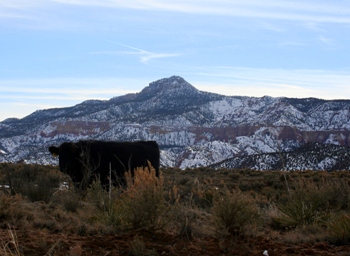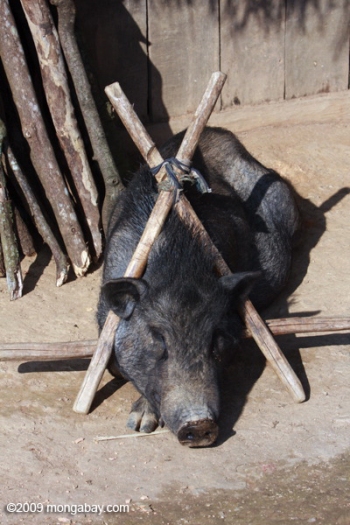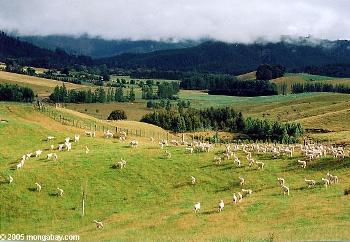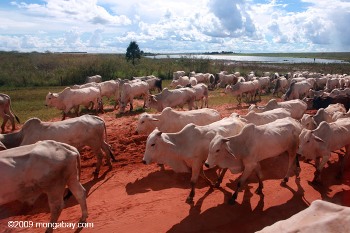While livestock may emit a smaller share of global greenhouse gases than thought, it’s overall environmental impact remains significant.
Meat is booming. In the past thirty years, livestock production has increased threefold. In many parts of the world where incomes are expanding, meat, once a delicacy, is now eaten regularly and voraciously. But what are the environmental impacts of this ‘livestock revolution’?
Two recent studies look at the global impact of the livestock industry, one alleges that its environmental impacts in relation to greenhouse gas emissions has been overestimated, while the other takes a holistic view of the industry’s environmental impact.
Questioning livestock’s share of emissions
 A cow stands against the background of New Mexico in the United States. Photo by: Jeremy Hance. |
Eating meat and dairy isn’t as bad for the climate as recently reported, according to research by air quality expert Dr. Frank Mitloehner from the University of California-Davis. A number of organizations and campaigns have linked meat-eating to higher carbon emissions; however Mitloehner says this is based on faulty data, at least in terms of comparing the importance of cutting down meat consumption to making the transition from fossil fuels to green energy.
“We certainly can reduce our greenhouse-gas production, but not by consuming less meat and milk,” said Mitloehner is a press release. “Producing less meat and milk will only mean more hunger in poor countries.”
Mitloehner says that an executive summary from a 2006 UN reports, entitled “Livestock’s Long Shadow” is partly responsible for the current sense that livestock are a major player in greenhouse gas emissions. According to the report global livestock is responsible for 18 percent of the world’s greenhouse gases—more than transportation.
However, Mitloehner says that the study measured the full lifecycle greenhouse gas emissions of livestock, including emissions from growing livestock feed, animals’ digestive emissions, and processing meat and milk into food products, whereas, the report only looked at the direct emissions created from transportation, i.e. the burning of fossils fuels.
“This lopsided analysis is a classical apples-and-oranges analogy that truly confused the issue,” Mitloehner said.
 A pig in Laos is punished for wandering. Photo by: Rhett A. Butler. |
He says that instead of focusing on cutting down on meat and dairy, the industrialized world must focus on the way it produces and consumes energy. For example, according to the EPA, in the US livestock emissions are approximately 3 percent of its total greenhouse gas emissions, while transportation is 26 percent, although this percentage gives less weight to carbon emitted due to land use changes than the UN figures.
He advises that “the developed world should focus on increasing efficient meat production in developing countries where growing populations need more nutritious food. In developing countries, we should adopt more efficient, Western-style farming practices to make more food with less greenhouse gas production.”
For many people in poor countries, meat when available and affordable is an important source of protein.
Impact still huge
So, livestock may make-up a smaller share of the world’s greenhouse gas emissions (an exact percentage was not given), but, on the other hand, livestock production does put a considerable strain on the environment, through pollution, water-consumption, deforestation, and land-use.
A second study conducted by an international team of scientists and policy experts recently looked at the booming livestock industry in a two volume report entitled ‘Livestock in a Changing Landscape’.
“The livestock industry is massive and growing,” said Harold A. Mooney, co-editor of the report and senior fellow at the Woods Institute for the Environment.
 Sheep cover New Zealand’s fields. Photo by: Rhett A. Butler. |
According to the report, livestock impact on land-use is massive. Currently, a quarter of the world’s land is used for 1.7 billion livestock animals. This ongoing shifting from wild lands to pasture has impacted biodiversity and ecosystems worldwide. For example, cattle ranching in Brazil has led both directly and indirectly to deforestation in the Amazon rainforest.
But this isn’t even the total land required for the world’s livestock. Livestock have to eat, and land—a lot of land—is required to feed everything from cattle to pigs to poultry. The report estimates that one third of the globe’s arable land is employed to grow food for livestock. In all, forty percent of the world’s agricultural gross domestic product goes to feeding livestock. Yet, according to the UN a record one billion people in the world do not have enough food.
However, the world’s poor certainly depend on livestock. “Too much animal-based protein is not good for human diets, while too little is a problem for those on a protein-starved diet, as happens in many developing countries,” Mooney said. The study points to a study in Kenya, which showed that children with access to meat-protein had better physical growth, cognitive function, and performed better in school than children who didn’t.
It is estimated that one billion poor derive at least some of their living from domestic animals. However, commercialized industrial livestock has reduced employment for many people, especially in countries such as India and China where large-scale industrial livestock production has replaced many small, rural livestock owners.
 Cattle in the Brazilian Amazon. Deforestation related to cattle is huge in Brazil: approximately 80 percent of deforested land in the Amazon becomes cattle pasture. Not only does such clearing threaten the Amazon’s biodiversity, but it releases significant amount of carbon into the atmosphere. Photo by: Rhett A. Butler. |
“We want to protect those on the margins who are dependent on a handful of livestock for their livelihood,” Mooney said. “On the other side, we want people engaged in the livestock industry to look closely at the report and determine what improvements they can make.”
Livestock production is an intensive industry consuming large amounts of water, fertilizer, pesticides, and fossil fuels—all of which contribute to global pollution and environmental degradation. Waste from the nearly 2 billion livestock is an additional environmental issue.
“Because only a third of the nutrients fed to animals are absorbed, animal waste is a leading factor in the pollution of land and water resources, as observed in case studies in China, India, the United States and Denmark,” the report reads.
Even after tripling in thirty years, the livestock industry is expected to continue growing: the report estimates that the industry could double by 2050.
“Without a change in current practices, the intensive increases in projected livestock production systems will double the current environmental burden and will contribute to large-scale ecosystem degradation unless appropriate measures are taken,” said co-editor Henning Steinfeld of the United Nations Food and Agriculture Organization (FAO).
“So much of the problem comes down to the individual consumer,” said co-editor Fritz Schneider of the Swiss College of Agriculture (SHL). “People aren’t going to stop eating meat, but I am always hopeful that as people learn more, they do change their behavior. If they are informed that they do have choices to help build a more sustainable and equitable world, they can make better choices.”
Whether such reports compel people to eat less meat, it is clear that in a world where the human population—and meat-consumption—continues to boom, the environmental impacts of raising (and eating) livestock can no longer be ignored, nor should the focus on livestock and the environment be only on greenhouse gas emissions, but water-consumption, pesticide and fertilizer use, deforestation, waste, biodiversity loss, and land-use.
Related articles
Commodity trade and urbanization, rather than rural poverty, drive deforestation

(02/07/2010) Deforestation is increasingly correlated to urban population growth and trade rather than rural poverty, suggesting that measures proposed to reduce deforestation will be ineffective if they fail to address demand for commodities produced on forest lands, argues a new paper published in Nature GeoScience.
Will it be possible to feed nine billion people sustainably?

(01/28/2010) Sometime around 2050 researchers estimate that the global population will level-out at nine billion people, adding over two billion more people to the planet. Since, one billion of the world’s population (more than one in seven) are currently going hungry—the largest number in all of history—scientists are struggling with how, not only to feed those who are hungry today, but also the additional two billion that will soon grace our planet. In a new paper in Science researchers make recommendations on how the world may one day feed nine billion people—sustainably.
(01/20/2010) Indigenous rights organization, Survival International, has awarded Brazilian cattle company, Yaguarete Porá S.A., its ‘Greenwashing Award 2010′ for destroying indigenous peoples’ forest—including uncontacted natives—and calling it conservation.
Brazil grants deforestation amnesty for farmers and ranchers
(12/14/2009) A decree issued by President Luiz Inacio Lula da Silva suspends up to $5.7 billion in fines and gives ranchers and farmers in the Amazon two more years to come into compliance with environmental laws aimed to curtain deforestation, reports the Associated Press.
Amazon cattle ranching accounts for half of Brazil’s CO2 emissions
(12/12/2009) Cattle ranching accounts for half of Brazil’s greenhouse gas emissions according to a new study led by scientists from Brazil’s National Space Institute for Space Research (INPE).
Cattle company bulldozing UNESCO site, threatening uncontacted natives

(12/09/2009) A Brazilian ranching company is bulldozing land within UNESCO Chaco Biosphere Reserve in Paraguay, home to the only uncontacted natives outside of the Amazon in South America. While the UNESCO status provides no legal protections to the area, it is meant as an international marker to protect the tribe of the Ayoreo-Totobiegosode and the forest they inhabit.
Deforestation emissions should be shared between producer and consumer, argues study

(11/19/2009) Under the Kyoto Protocol the nation that produces carbon emission takes responsibility for them, but what about when the country is producing carbon-intensive goods for consumer demand beyond its borders? For example while China is now the world’s highest carbon emitter, 50 percent of its growth over the last year was due to producing goods for wealthy countries like the EU and the United States which have, in a sense, outsourced their manufacturing emissions to China. A new study in Environmental Research Letters presents a possible model for making certain that both producer and consumer share responsibility for emissions in an area so far neglected by studies of this kind: deforestation and land-use change.
Brazilian beef giants agree to moratorium on Amazon deforestation
(10/07/2009) Four of the world’s largest cattle producers and traders have agreed to a moratorium on buying cattle from newly deforested areas in the Amazon rainforest, reports Greenpeace.
Concerns over deforestation may drive new approach to cattle ranching in the Amazon

(09/08/2009) While you’re browsing the mall for running shoes, the Amazon rainforest is probably the farthest thing from your mind. Perhaps it shouldn’t be. The globalization of commodity supply chains has created links between consumer products and distant ecosystems like the Amazon. Shoes sold in downtown Manhattan may have been assembled in Vietnam using leather supplied from a Brazilian processor that subcontracted to a rancher in the Amazon. But while demand for these products is currently driving environmental degradation, this connection may also hold the key to slowing the destruction of Earth’s largest rainforest.
Activists target Brazil’s largest driver of deforestation: cattle ranching

(09/08/2009) Perhaps unexpectedly for a group with roots in confrontational activism, Amigos da Terra – Amazônia Brasileira is calling for a rather pragmatic approach to address to cattle ranching, the largest driver of deforestation in the Brazilian Amazon. The solution, says Roberto Smeraldi, founder and director of Amigos da Terra, involves improving the productivity of cattle ranching, thereby allowing forest to recover without sacrificing jobs or income; establishing a moratorium on new clearing; and recognizing the economic values of maintaining the ecological functions of Earth’s largest rainforest.
Brazilian beef giant announces moratorium on rainforest beef

(08/13/2009) Brazil’s second-largest beef exporter, Bertin, announced it would establish a moratorium on buying cattle from farms involved in Amazon deforestation, reports Greenpeace. The move comes after the World Bank’s International Finance Corporation (IFC) withdrew a $90 million loan to Bertin following revelations in a Greenpeace report that the company was buying beef produced on illegally deforested lands. The report, which linked some of the world’s most prominent brands to rainforest destruction in the Amazon, had an immediate impact, triggering a cascade of events.
Timberland announces policy to avoid using leather produced by Amazon destruction

(07/29/2009) Timberland, a maker of hiking boots and other footwear, today announced it would demand a moratorium on leather produced from newly deforested areas in the Amazon. The move is a direct response to pressure from Greenpeace, which last month released Slaughtering the Amazon, a report that linked some of the world’s most prominent brands to illegal clearing of the Amazon rainforest. Timberland says it will require its leather suppliers to commit to the moratorium on newly deforested areas in the Amazon. Greenpeace says the policy “makes Timberland the industry leader in environmentally and socially responsible Brazilian leather procurement.”
Nike implements policy to avoid leather produced via Amazon deforestation
(07/22/2009) Nike is working with Greenpeace to ensure its products don’t contribute to destruction of the Amazon rainforest, according to statements from the shoe giant and the environmental activist group. The partnership comes after Greenpeace report accused Nike of using leather derived from cattle raised on illegal deforested Amazon land. The report, “Slaughtering the Amazon”, also linked other shoemakers to rainforest destruction, including Adidas, Reebok and Timberland.
Brazil’s development bank to require beef-tracking system to avoid illegal Amazon deforestation
(07/01/2009) Responding to allegations that major Brazilian cattle producers are responsible for illegal forest clearing in the Amazon, Brazil’s development bank BNDES will soon require processors to trace the origin of beef back to the ranch where it was produced in order to qualify for loans, reports Brazil’s Agencia Estado. The traceability program aims to ensure that cattle products do not come from illegally deforested land.
Tesco responds to allegations of causing Amazon deforestation
(06/29/2009) Tesco, one of Europe’s largest retailers, has sent a response to the British newspaper The Guardian in light of the paper’s coverage of recent allegations that the chain store sells beef and leather products that caused deforestation of the Amazon.
Brazilian cattle giant declares moratorium on Amazon deforestation

(06/25/2009) Marfrig, the world’s fourth largest beef trader, will no longer buy cattle raised in newly deforested areas within the Brazilian Amazon, reports Greenpeace. The announcement is a direct response to Greenpeace’s Slaughtering the Amazon report, which linked illegal Amazon forest clearing to the cattle producers that supply raw materials to some of the world’s most prominent consumer products companies. Marfrig was one several cattle firms named in the investigative report.
Cattle giant JBS facing corruption probe
(06/17/2009) JBS, the world’s largest beef processor, is under investigation by Brazil’s federal prosecutor’s office for corruption, reports Reuters.
World Bank revokes loan to Brazilian cattle giant accused of Amazon deforestation

(06/13/2009) The Work Bank’s private lending arm has withdrawn a $90 million loan to Brazilian cattle giant Bertin, following Greenpeace’s release of a report linking Bertin to illegal deforestation of the Amazon rainforest, report environmental groups, Friends of the Earth-Brazil and Greenpeace. The loan, granted by the International Finance Corporation (IFC) in March 2007, was to expand Bertin’s meat-processing in the Brazilian Amazon. At the time, the IFC promoted the loan as a way to promote environmentally responsible beef production in the Amazon, although environmental groups — including Friends of the Earth-Brazil and Greenpeace — criticized the move.
Wal-Mart bans beef illegally produced in the Amazon rainforest

(06/12/2009) Brazil’s three largest supermarket chains, Wal-Mart, Carrefour and Pão de Açúcar, will suspend contracts with suppliers found to be involved in Amazon deforestation, reports O Globo. The decision, announced at a meeting of the Brazilian Association of Supermarkets (Abras) this week, comes less than two weeks after Greenpeace’s exposé of the Amazon cattle industry. The report, titled Slaughtering the Amazon, linked some of the world’s most prominent brands — including Nike, Toyota, Carrefour, Wal-Mart, and Johnson & Johnson, among dozens of others — to destruction of the Amazon rainforest for cattle pasture.